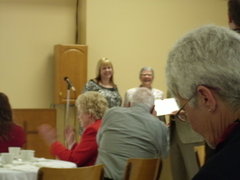I spent most of the day on the Library and Archives Canada site looking up my ancestors' land petitions. I found quite a few, some I knew about and others were a complete surprise. The biggest surprise was when I started reading my 6th great-grandfather's petition. The surprise was that he wasn't considered a loyalist!
Titus Doan, Sr. came from New Jersey in 1785 with his wife and children. He said in his petition that he aided the British army with food and shelter when they came to Trenton and he had to flee from persecution as a "tory" by the "whigs". He lost his property and two horses. Because of his Quaker faith he was not considered a "loyalist", merely a "settler".
Elijah Doan came to Upper Canada before 1790 with his wife and children after reading the circular about the Simcoe Proclamation. He was granted land as a settler.
Another surprise was my 3rd great-grandmother, Lydia ? Haines. Nathaniel Haines, her husband, drew up a petition for land on her behalf as the daughter of a loyalist in 1796. She stated that some of her brothers fought with the Butler's Rangers. As far as I can tell form reading the petition, she was granted land. The information I found on Ancestry.ca was that she didn't qualify as she was not the daughter of a loyalist. If she was born in the thirteen colonies and her brothers joined the Butler's Rangers, she may qualify as a loyalist in her own right. She was married in Niagara in 1786. I just have to keep searching for her maiden name.
I found my 2nd great-grandfather, Benjamin Haines' petition for land as well in 1836. It was after his father's death and he had an affidavit stating that he was Nathaniel Haines' son. I found his sister, Catherine Haines Risenburg"s petition as well in 1808. She doesn't have an affidavit with hers so I am assuming he was still living in 1808.
I located Minor Bradt and his son, William's land petitions as well. I'm researching my husband's family as well as two of my grandchidren's and they both descend from William's grandson, Charles Bradt. They also have Van Alstine, Hooper and McKinnon ancestors, possibly more loyalist connections.
I noticed something about my loyalist ancestors, most of them signed their name with an X. I think my great-grandfather's generation is the first to have a formal education. Something that nowadays is taken for granted was not an option for the early loyalists.

